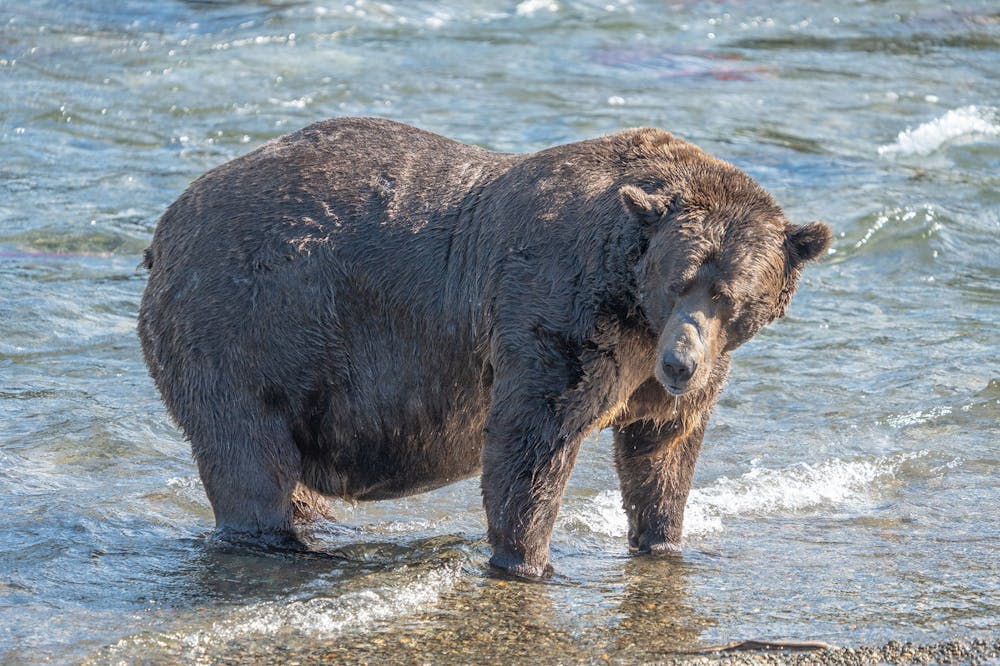Fat Bear Week is an annual celebration that takes place in Katmai National Park and Preserve, Alaska and runs from Oct. 4 to Oct. 10. The event is a fun and unique way to acknowledge and appreciate the survival of brown bears in this wild and pristine environment. Fat Bear Week centers around the idea that fat bears are the ultimate champions in this natural competition for survival.
Following an entire summer filled with indulgent salmon meals, a brown bear known as 'Grazer' has claimed victory in this year's Fat Bear Week competition.
Grazer, is an awe-inspiring behemoth of a creature, boasting an astonishing weight that tips the scales at 700-800 pounds. With each step, Grazer’s sheer size and power are on full display, demonstrating the remarkable resilience and might of this extraordinary champion.
Fat Bear Week operates as a tournament-style bracket competition with several key steps. Initially, park rangers construct a bracket in which individual bears are matched against each other. Subsequently, the public is encouraged to cast their votes for their preferred bear in each round, with the freedom to apply their own criteria for selection. The voting process unfolds over several days on the official Fat Bear Week website.
Beyond the voting process, the event offers online chats led by Explore.org's resident naturalist and Katmai rangers. These chats provide valuable insights into individual bears and the thriving ecosystem of Katmai.
Fat bears epitomize the essence of survival, during the harsh winter months, these bears retreat to their dens, relying solely on their accumulated fat reserves for sustenance.
The robust size of these bears is a testament to the extraordinary wealth of food resources found in Katmai, including the planet's largest and healthiest runs of sockeye salmon. In this pristine wilderness, the bear population outnumbers the human population, showcasing the remarkable richness and biodiversity of this untamed environment.
Victoria Schmalhofer, an ecologist and assistant director at the Center for Earth and Environmental Science at IUPUI, provides valuable insights into the fascinating world of bears and their hibernation patterns. Schmalhofer holds a Ph.D. in ecology and specializes in teaching wetland ecosystems (GEOL-G 431) and service learning in geology (GEOL-G 199).
“Whatever its form, hibernation is a mechanism for saving energy. Grizzlies live in a region where food is seasonally superabundant, late summer/early fall has lots of fruits and nuts and roots and salmon, but also seasonally extremely scarce, winter has basically nothing available for food except other mammals,” Schmalhofer said.
Schmalhoefer speaks more on the importance of hibernation for bears.
“Hibernation is essential for bears as it enables them to survive periods of food scarcity by conserving energy through a reduced metabolic state,” Schmalhoefer said. “This physiological adaptation helps them endure harsh winter conditions, relying on stored body fat when food sources are limited.”
For female bears, hibernation also serves as a reproductive strategy, providing a safe environment in dens for giving birth and raising cubs. By lowering their metabolic rate and minimizing activity, hibernating bears preserve muscle mass and minimize disturbances, ensuring their survival in challenging environments where resources are scarce.
“Hibernation is the mechanism that lets mammals, “during the period of scarcity,” slowly utilize the energy stored up during the period of superabundance. To be effective, hibernation requires a mammal to store a lot of energy. So bears need to put on a lot of mass to have sufficient reserves to get through the winter,” Schmalhofer said.
Next year's Fat Bear Week competition will happen at the same time in late September early October.





